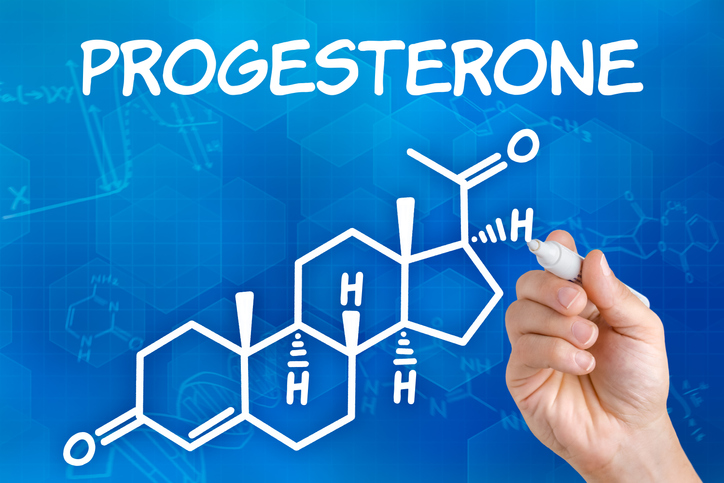Why Progesterone Is Just as Important as Oestrogen
Women are told they have no need for progesterone after a hysterectomy or as they get older, but bioidentical experts clearly disagree.

One of the questions I am most frequently asked, or even told, is that women have no need for progesterone after a hysterectomy or as they get older.
Clearly this is not a view that is held by bioidentical doctors who know that women need both oestrogen and progesterone throughout their lives as they are our key hormones.
However it is usually oestrogen that is recommended, and women are told that they need, but progesterone’s an essential hormone throughout life both to balance oestrogen excess known as oestrogen dominance, and provide protection from the risks of hormonal cancers, strokes, heart disease and osteoporosis.
I thought I would share with you thoughts on this subject from the practice of Lara Briden, a naturopathic doctor and a very experienced practitioner in issues in relation to bioidentical hormones, from from her work in Canada, Australia and New Zealand.
From Lara Briden
It’s time to bring progesterone into the conversation about women’s health. That’s according to Canadian endocrinology Professor Jerilynn Prior, who released an important paper called “Women’s Reproductive System as Balanced Estradiol and Progesterone Actions—a revolutionary, paradigm-shifting concept in women’s health.”
In the paper, Professor Prior makes the case that historically there has been a “cultural over-emphasis on estrogen” while “progesterone tends to be ignored or associated with negative effects.”
How science got it wrong about progesterone
Why has progesterone been ignored or blamed for side effects it does not cause?
Progesterone was discovered a few years after estrogen and therefore missed the opportunity to be part of the perfect dichotomy of “testosterone for men and estrogen for women.”
Unlike estrogen, progesterone originally was not effective when taken orally which meant it was of little interest to the “the estrogen-discovering scientists, the estrogen-treating clinicians and the estrogen-making pharmaceutical manufacturers, [who] all worked together.”
Progesterone was rapidly replaced by synthetic progestins in both research and treatment even though progesterone has different — and sometimes opposite — effects compared to progestins. The result of the progesterone-progestin confusion is that progesterone has been mistakenly blamed for progestin side effects and risks including mood disturbance, hair loss, and breast cancer.
Estrogen and progesterone work together to build long-term health and in reality, of course, women have two main ovarian hormones, not one; and physiologically, estrogen and progesterone work as a team.
For example, a pre-ovulatory surge of estrogen (estradiol) is necessary for ovulation and the manufacture of progesterone. Estrogen also works in every tissue to facilitate the production of progesterone receptors in those same tissues.
In turn, progesterone counterbalances estrogen in all parts of the body including:
– the uterus, where it thins the lining, while estrogen thickens it;
– the brain, where it is calming, while estrogen is stimulating;
– the breasts, where progesterone helps to slow cell division, while estrogen increases cell division.
Progesterone also promotes a healthy menstrual cycle by providing important hormonal feedback to the hypothalamus.
Did you know?
On a blood test, a good peak luteal phase progesterone level is 80 nmol/L which is 100 times more than an average peak estradiol level of 800 pmol/L (0.8 nmol/L).
Together, estrogen and progesterone promote the long-term health of the brain, bones and cardiovascular system. As Professor Prior says in her paper, “normally ovulatory cycles across a woman’s long reproductive life span are needed to prevent osteoporosis and fracture, heart attacks, and breast and endometrial cancers during women’s older years.”
Do you make enough progesterone?
Ovulation is how you make progesterone, so if you have regular healthy ovulatory menstrual cycles, you probably make enough progesterone.
Definition: A healthy ovulatory cycle is a menstrual cycle in which your basal body temperatures go up with ovulation and stay up for at least 11 days, indicating a healthy luteal phase.
Conversely, if you have only a slight temperature rise and/or a short luteal phase, you have ovulatory disturbance and so make insufficient progesterone. If you have no temperature rise, you have anovulatory cycles, and so make no progesterone.
Finally, if you take almost any type of hormonal birth control you do not ovulate and so make no progesterone. And there’s no progesterone in any type of hormonal birth control, but are all synthetic progestins, not progesterone.
Progesterone as treatment
As Professor Prior says in her paper, the first step is “to make visible progesterone’s… presence or absence.” That means tracking ovulation with temperatures or an at-home progesterone test. Knowing if and when you ovulate is called body literacyt.
The next step is to promote healthy ovulation (and therefore progesterone) by reducing stress and promoting optimal general health. Because ovulation is an expression of general health, regular natural menstruation is recognized by the American College of Obstetricians and Gynecologists (ACOG) as a “vital sign,” or what I call a “monthly report card.”
Finally, bioidentical progesterone can be used twice daily for 14 days per cycle, which is a promising treatment for PCOS, irregular cycles, and the heavy bleeding of perimenopause.
Helpful information:
Women are usually told they have no need for progesterone after a hysterectomy or menopause, but clearly it is an essential hormone throughout life.
Women are subject to excess oestrogen from the environment, from xenoestrogens, and hormonal products such as the pill, coil, HRT and implants.
As naturopathic doctor Lara Briden explains, the majority of products women believe contain progesterone such as the pill, coil and HRT contain no progesterone at all but the synthetic equivalents which mimic the action of the real hormone but do not have the same benefits.
For more information about progesterone and perimenopause visit www.Larabriden.com
If you are not sure about which hormone or hormones you may need this article will be helpful.
https://anna.blog.wellsprings-health.com/which-hormone-or-hormones-might-you-need/


















